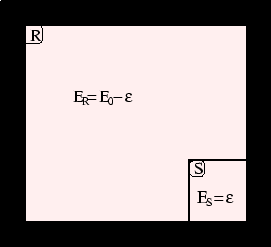We consider a system ![]() in contact with a heat reservoir
in contact with a heat reservoir ![]() , the whole forming an isolated system with energy
, the whole forming an isolated system with energy
![]() .
.

Heat can be exchanged between the system and reservoir, and the likelihood of a particular partition
depends on the number of microstates of the whole system ![]() corresponding to that partition. (The equilibrium
partition will be the one which maximises the number of microstates, but that is not what we are interested in
here.) Since the system and reservoir are independent, the total number of microstates factorises:
corresponding to that partition. (The equilibrium
partition will be the one which maximises the number of microstates, but that is not what we are interested in
here.) Since the system and reservoir are independent, the total number of microstates factorises:
![]()
Now suppose we specify the microstate of ![]() that we are interested in, say the
that we are interested in, say the ![]() th
(with energy
th
(with energy ![]() ) and ask what the
probability
) and ask what the
probability ![]() of finding the system in that microstate is. It will be proportional to the number of microstates
of finding the system in that microstate is. It will be proportional to the number of microstates
![]() of the whole system
of the whole system ![]() . However
. However ![]() as we've specified the state of
as we've specified the state of ![]() , so
, so
![]()
Using the relation between ![]() and entropy, we can write
and entropy, we can write

![$\mbox{\large\colorbox{yellow}{\rule[-3mm]{0mm}{10mm} \
$\displaystyle p_i={e^{-\varepsilon_i/k_{\scriptscriptstyle B}T} \over Z}$ }}$](img530.gif)
The normalisation constant ![]() is found by saying that the probability that the system is in some
microstate is one:
is found by saying that the probability that the system is in some
microstate is one: ![]() , so
, so